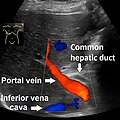Common bile duct
| Common bile duct | |
|---|---|
 Diagram of the biliary tree showing the common bile duct | |
| Details | |
| Part of | Biliary tract |
| Identifiers | |
| Latin | ductus choledochus,[1] ductus biliaris[1] |
| Acronym(s) | CBD[2] |
| MeSH | D003135 |
| TA98 | A05.8.02.013 |
| TA2 | 3103 |
| FMA | 14667 |
| Anatomical terminology | |
18. Small intestine: 19. Duodenum, 20. Jejunum
21–22. Right and left kidneys.
The front border of the liver has been lifted up (brown arrow).[3]
The bile duct
Anatomy
The bile duct is some 6–8 cm long, and normally up to 8 mm in diameter.[4]
Its proximal supraduodenal part is situated within the free edge of the lesser omentum. Its middle retroduodenal part is oriented inferiorly and right-ward, and is situated posterior to the first part of the duodenum, and anterior to the inferior vena cava. Its distal paraduodenal part is oriented still more right-ward, is accommodated by a groove upon (sometimes a channel within) the posterior aspect of the head of the pancreas, and is situated anterior to the right renal vein.[4]
The bile duct terminates by uniting with the
The distal extremity of the bile duct invariably features its own sphincteric muscle (the pancreatic duct and the hepatopancreatic ampulla usually possess sphincters of their own to allow the flow of pancreatic juice to be regulated independently, however, these two can be absent).[4]
Clinical significance
Several problems can arise within the common bile duct, usually related to its obstruction. Opinions vary slightly on the maximum calibre of a normal CBD, but 6mm is one accepted upper limit of normal [5] with a further 1mm diameter allowed for each decade over 60 years.
It normally gets slightly dilated after cholecystectomy, with upper limit (95% prediction interval) being about 10 mm after a few months.[6]
On
-
Borderline of a dilated perihilar bile duct, measuring 8 mm.
-
Dilatation of CBD due to Ampullary tumor.
Obstruction
Tumours in the head of the pancreas may come to obstruct the distal bile duct.[4]
If obstructed by a
History
Obstruction of the common bile duct and related jaundice has been documented since at least since the time of Erasistratus.[8]
Additional images
-
The gall-bladder and bile ducts laid open.
See also
- Choledochoduodenostomy - a surgical procedure to create a connection between the common bile duct (CBD) and an alternative portion of the duodenum.
References
- ^ a b c "Anatonomina". terminologia-anatomica.org. Retrieved 2023-07-07.
- ISBN 9781609133603.
- ISBN 978-0-8089-2371-8.
- ^ ISBN 978-0-7295-3752-0.
- ^ Oh, Lawrence. "Common bile duct | Radiology Reference Article | Radiopaedia.org". Radiopaedia. Retrieved 2021-08-30.
- PMID 7676981.
- ISBN 978-0781719377.
- ISBN 9400941730.
- Miederer, S.; Lindstaedt, H.; Siedek, M.; Franken, Th. (1978). "Endoskopische transpapilläre Spaltung einer Choledochocele" [Endoscopic transpapillary Splitting of a choledochocele]. Deutsche Medizinische Wochenschrift (in German). 103 (5): 216–219. PMID 631041.
External links
- Anatomy figure: 38:06-08 at Human Anatomy Online, SUNY Downstate Medical Center—"The gallbladder and extrahepatic bile ducts."
- Anatomy image:8336 at the SUNY Downstate Medical Center
- Anatomy image:7957 at the SUNY Downstate Medical Center
- Liver at The Anatomy Lesson by Wesley Norman (Georgetown University) (biliarysystem)



